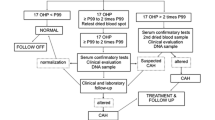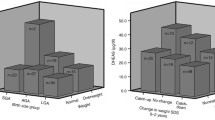Abstract
Blood samples from 813 newborns were spotted on to filter paper and the 17-hydroxyprogesterone concentration was measured using the Delfia (R) fluorometric immunoassay. The median, mean, and standard deviation (SD) for the total population were 20, 21 and (11) nmol/L respectively. Males had significantly higher levels than females with median, mean and (SD) of 22, 22 and (12) nmol/L. Similarly, low birth weight babies were found to have significantly higher levels than normal birth weight babies with median, mean and (SD) of 21, 24 (12) nmol/L. Preterm babies were also found to have significantly higher levels than full term babies, with median, mean and (SD) of 25, 29 (16) nmol/L. As experienced elsewhere, those factors should be taken into consideration when considering a cut-off point in any neonatal screening program for congenital adrenal hyperplasia.
Similar content being viewed by others
References
Pang S, Murphey W, Levine IS et al. A pilot newborn screening for congenital adrenal hyperplasia in Alaska.J Clin Endocrinol Metab 1982; 55: 413–420.
Pang et al. Congenital adrenal hyperplasia due to 21-hydroxylase deficiency. Newborn screening and its relationship to the diagnosis and treatment of the disorder.Screening 1993; 2: 105–139.
Cacciari F, Balsamo A, Cassio A et al. Neonatal screening for congenital adrenal hyperplasia using a microfilter paper method for 17-hydroxyprogesterone radioimmunoassay.Horm Res 1982; 16: 4–9.
Wallace. et al Neonatal Screening for congenital adrenal hyperplasia. A programme based on novel direct radioimmunoassay for 17-hydroxyprogesterone in blood spots.J Endocrinol 1986; 2: 105–139.
Berry J, Betts P, Wood PJ. The interpretation of blood spot 17-hydroxyprogesterone levels in term and perterm neonates.Ann Clin Biochem 1986; 23: 546–551.
Shimozawa K, Matsumotom, Okado K et al. Analysis of blood spot 17-hydroxyprogesterone concentration in neonates.Horn Res 1988; 30: 246–251.
Hughes IA, Riad-Fahmy D, Griffith K. Plasma 17-hydroxyprogesterone concentrations in newborn infants.Arch Dis Child 1979; 54: 347–349.
Larsson A, Hagenfeldt L, Von Dobeln U et al. Neonatal screening for congenial adrenal hyperplasia using 17-hydroxyprogesterone assay in filter paper blood spots.Horm Res 1988; 30: 235–240.
Author information
Authors and Affiliations
Rights and permissions
About this article
Cite this article
Al-Nuaim, A.R., Abdullah, M.A., Stevens, B. et al. Effect of gender, birth weight and gestational age on serum 17-hydroxyprogesterone concentration and distribution among neonates in Saudi Arabia. Indian J Pediatr 62, 605–609 (1995). https://doi.org/10.1007/BF02761890
Issue Date:
DOI: https://doi.org/10.1007/BF02761890




